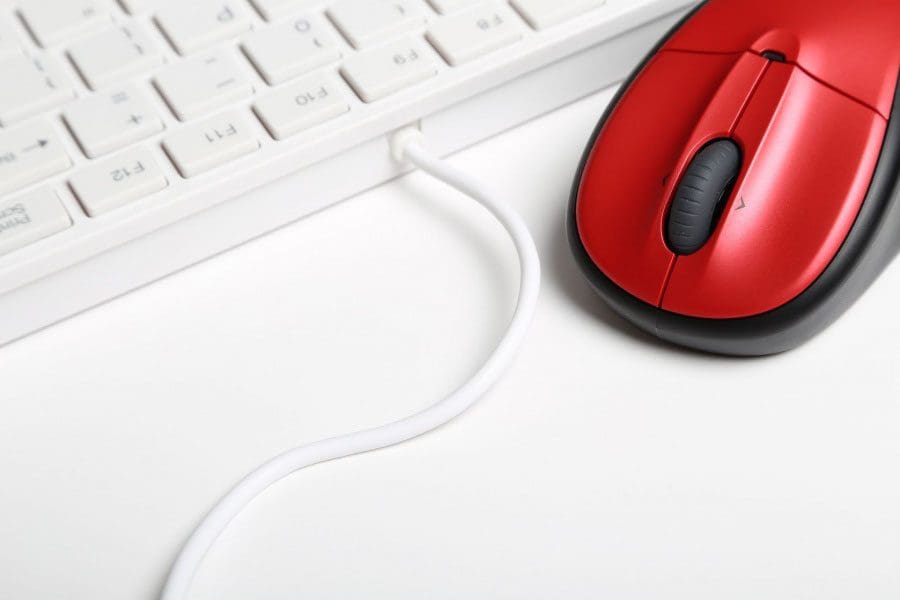Keyboards and mice come in all sorts of colors and styles, which is great but for those that work on a computer for a job, using the right type is essential to prevent injury keeping the hands, wrists, and arms healthy and moving.
Overuse can cause painful musculoskeletal disorders like:
- Tendonitis
- Tendosynovitis
- Carpal tunnel syndrome
There are a variety of ergonomic designs for these devices. Keyboard designs include four separate key areas:
- The alphanumeric area with letters, numbers, and control keys
- An area with cursor keys
- Numeric keypad
- Function keys or the ‘F’ keys

Contents
Keyboard Key Combinations or The Mouse
Basic typing and many other actions can be performed on the keyboard using the:
- Function keys
- Cursor keys
- Control keys
- Keyboard macros
Pretty much all of these actions can be done with the mouse. Many users operate the computer with the mouse instead of using the key combinations.
To obtain correct posture when working align the center of your body with the center of the keyboard area used the most or during a task.
Keyboard Layout
The layout follows the original ASDF design from the first typewriter.
From the beginning of this design, there was a realization that angling and splitting the keys would reduce the bending of the hands. The first split keyboard typewriter was manufactured in 1886.
The idea of splitting and angling the keys was implemented into ergonomic keyboard designs with the alphanumeric keys being separated at an angle into two sloped sections. For a� non-touch typist, this can be difficult to use, as some keyboards only angle the keys without splitting into halves.
The split design reduces the sideways bending of the hand but also important is the reduction of vertical bending.
However, this can be overcome by taking some simple steps like:
- Flattening the keyboard feet on the desk can keep the hands flat
- Putting the keyboard on a vertical tilted tray can also help improve the hands’ posture
- Keyboards are available in left and right-handed styles

Choosing a Mouse
The shape along with the location of the mouse in relation to the keyboard is important for maintaining a healthy hand posture. Here are some considerations when choosing a mouse. The mouse buttons should:
- Have easy clickability
- Is easy to move around/feels natural
- The screen cursor should move accurately with your movements
There are mice with programmable buttons allowing you to control additional functions. Important things to check:
- Make sure the size and shape of the mouse feels natural in your hand
- Hold the mouse in a neutral position meaning your hand should not be bent up, down or sideways
- Position and operate the mouse with your upper arm relaxed and close to your body, and don’t reach too far forward or too far out to the side
There are keyboards with a separate numeric pad that allows the mouse to be located closer to the keyboard. Some keyboards include a cursor positioning device like a trackball, touchpoint or touchpad. These types eliminate having to reach for a mouse. However, it is a good practice to mix it up using the keyboard for certain operations and the mouse for others. This allows different muscles and ligaments to work while the others take a break.
The Ideal Setup
All keyboards and mice are designed differently. The key is to find well-made products that are built with ergonomic injury prevention as the focus. You can use trackballs, touchpads, and pen mice instead of a regular mouse.
Find what works for you, is ergonomic, comfortable and easy to use and will keep your hands in a neutral posture. If you do a lot of typing and mouse movement, your hands are going to get tired even with top designed keyboards and mice. Take frequent short rest and stretch breaks to let your muscles recover. The stretching exercises should include the:
- Wrist
- Forearm muscles
- Shoulders
- Neck
- Upper back muscles
Working like this will protect you against over-use injuries.
Carpal Tunnel Chiropractic Treatment
NCBI Resources
Chiropractic care is one of the most common forms of treatment for carpal tunnel syndrome. Foremost, a doctor of chiropractic will evaluate the extent of the condition as well as diagnose the individual to determine any underlying cause behind the condition. Through a series of chiropractic adjustments and manual manipulations, the hand, wrist, and arm are adjusted to reduce the pressure around the median nerve, and ultimately reducing the symptoms.
General Disclaimer, Licenses and Board Certifications *
Professional Scope of Practice *
The information herein on "Working With an Ergonomic Keyboard and Mouse El Paso, TX." is not intended to replace a one-on-one relationship with a qualified health care professional or licensed physician and is not medical advice. We encourage you to make healthcare decisions based on your research and partnership with a qualified healthcare professional.
Blog Information & Scope Discussions
Welcome to El Paso's Premier Wellness and Injury Care Clinic & Wellness Blog, where Dr. Alex Jimenez, DC, FNP-C, a Multi-State board-certified Family Practice Nurse Practitioner (FNP-BC) and Chiropractor (DC), presents insights on how our multidisciplinary team is dedicated to holistic healing and personalized care. Our practice aligns with evidence-based treatment protocols inspired by integrative medicine principles, similar to those on this site and on our family practice-based chiromed.com site, focusing on naturally restoring health for patients of all ages.
Our areas of multidisciplinary practice include Wellness & Nutrition, Chronic Pain, Personal Injury, Auto Accident Care, Work Injuries, Back Injury, Low Back Pain, Neck Pain, Migraine Headaches, Sports Injuries, Severe Sciatica, Scoliosis, Complex Herniated Discs, Fibromyalgia, Chronic Pain, Complex Injuries, Stress Management, Functional Medicine Treatments, and in-scope care protocols.
Our information scope is multidisciplinary, focusing on musculoskeletal and physical medicine, wellness, contributing etiological viscerosomatic disturbances within clinical presentations, associated somato-visceral reflex clinical dynamics, subluxation complexes, sensitive health issues, and functional medicine articles, topics, and discussions.
We provide and present clinical collaboration with specialists from various disciplines. Each specialist is governed by their professional scope of practice and their jurisdiction of licensure. We use functional health & wellness protocols to treat and support care for musculoskeletal injuries or disorders.
Our videos, posts, topics, and insights address clinical matters and issues that are directly or indirectly related to our clinical scope of practice.
Our office has made a reasonable effort to provide supportive citations and has identified relevant research studies that support our posts. We provide copies of supporting research studies upon request to regulatory boards and the public.
We understand that we cover matters that require an additional explanation of how they may assist in a particular care plan or treatment protocol; therefore, to discuss the subject matter above further, please feel free to ask Dr. Alex Jimenez, DC, APRN, FNP-BC, or contact us at 915-850-0900.
We are here to help you and your family.
Blessings
Dr. Alex Jimenez DC, MSACP, APRN, FNP-BC*, CCST, IFMCP, CFMP, ATN
email: coach@elpasofunctionalmedicine.com
Multidisciplinary Licensing & Board Certifications:
Licensed as a Doctor of Chiropractic (DC) in Texas & New Mexico*
Texas DC License #: TX5807, Verified: TX5807
New Mexico DC License #: NM-DC2182, Verified: NM-DC2182
Multi-State Advanced Practice Registered Nurse (APRN*) in Texas & Multi-States
Multi-state Compact APRN License by Endorsement (42 States)
Texas APRN License #: 1191402, Verified: 1191402 *
Florida APRN License #: 11043890, Verified: APRN11043890 *
License Verification Link: Nursys License Verifier
* Prescriptive Authority Authorized
ANCC FNP-BC: Board Certified Nurse Practitioner*
Compact Status: Multi-State License: Authorized to Practice in 40 States*
Graduate with Honors: ICHS: MSN-FNP (Family Nurse Practitioner Program)
Degree Granted. Master's in Family Practice MSN Diploma (Cum Laude)
Dr. Alex Jimenez, DC, APRN, FNP-BC*, CFMP, IFMCP, ATN, CCST
My Digital Business Card
Licenses and Board Certifications:
DC: Doctor of Chiropractic
APRNP: Advanced Practice Registered Nurse
FNP-BC: Family Practice Specialization (Multi-State Board Certified)
RN: Registered Nurse (Multi-State Compact License)
CFMP: Certified Functional Medicine Provider
MSN-FNP: Master of Science in Family Practice Medicine
MSACP: Master of Science in Advanced Clinical Practice
IFMCP: Institute of Functional Medicine
CCST: Certified Chiropractic Spinal Trauma
ATN: Advanced Translational Neutrogenomics
Memberships & Associations:
TCA: Texas Chiropractic Association: Member ID: 104311
AANP: American Association of Nurse Practitioners: Member ID: 2198960
ANA: American Nurse Association: Member ID: 06458222 (District TX01)
TNA: Texas Nurse Association: Member ID: 06458222
NPI: 1205907805
| Primary Taxonomy | Selected Taxonomy | State | License Number |
|---|---|---|---|
| No | 111N00000X - Chiropractor | NM | DC2182 |
| Yes | 111N00000X - Chiropractor | TX | DC5807 |
| Yes | 363LF0000X - Nurse Practitioner - Family | TX | 1191402 |
| Yes | 363LF0000X - Nurse Practitioner - Family | FL | 11043890 |









